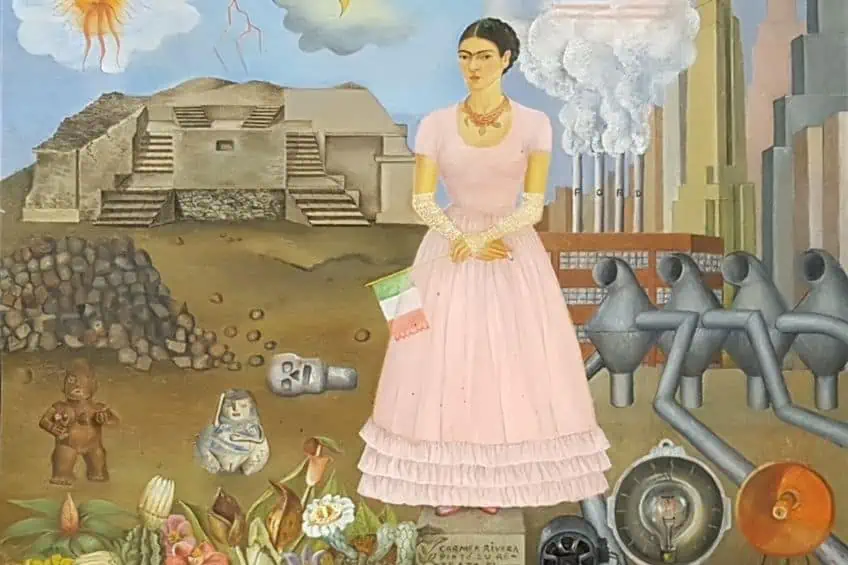Famous Mexican Painters – A List of the 10 Best Artists
Famous Mexican painters is an exploration of the rich and vibrant world of artistry that emanates from the heart of Mexico. This article delves into the extraordinary contributions of Mexican artists, shedding light on the remarkable legacy left by painters from Mexico who have captivated the global art scene with their exceptional talent and cultural influence. From the iconic works of Diego Rivera to the surreal creations of Frida Kahlo, this article offers an immersive journey through the captivating and diverse world of Mexican artistry, showcasing the enduring impact of these talented painters on the global stage.
Contents
- 1 Getting to Know Famous Mexican Painters
- 1.1 Joaquín Clausell (1866 – 1935)
- 1.2 Diego Rivera (1886 – 1957)
- 1.3 Adolfo Best Maugard (1891 – 1964)
- 1.4 David Alfaro Siqueiros (1896 – 1974)
- 1.5 Rufino Tamayo (1899 – 1991)
- 1.6 Rosario Cabrera (1901 – 1975)
- 1.7 María Izquierdo (1902 – 1955)
- 1.8 Frida Kahlo (1907 – 1954)
- 1.9 Francisco Eppens Helguera (1913 – 1990)
- 1.10 Julio Galán (1958 – 2006)
- 2 Frequently Asked Questions
Getting to Know Famous Mexican Painters
This section of the article is dedicated to providing readers with an insightful glimpse into the lives, inspirations, and artistic journeys of some of Mexico’s most renowned painters. In this segment, we embark on a journey that goes beyond the canvas and delves deep into the hearts and minds of these iconic artists, revealing the profound cultural and historical influences that have shaped their work. Through engaging narratives and illuminating anecdotes, we invite you to become intimately acquainted with the stories and artistic visions of these celebrated Mexican painters, gaining a richer appreciation for their enduring contributions to the world of art.

Joaquín Clausell (1866 – 1935)
| Date of Birth | 16 June 1866 |
| Date of Death | 28 November 1935 |
| Place of Birth | Campeche, Mexico |
| Art Movements | Impressionism |
| Popular Themes | Landscape and experiments with color |
Joaquín Clausell was a pioneering Mexican artist who left an indelible mark on the art scene of his time. Born in Campeche, Mexico, Clausell’s artistic journey was characterized by a profound connection to nature and a dedication to capturing the essence of the Mexican landscape.
His landscapes, often rendered in a post-impressionist style, are celebrated for their vivid colors and distinctive brushwork.
Clausell’s unique ability to convey the vibrant and ever-changing natural beauty of Mexico earned him recognition as a forerunner of Mexican landscape painting. Beyond his artistic contributions, Clausell’s commitment to fostering artistic education and his role in shaping the cultural landscape of Mexico remain integral parts of his enduring legacy, solidifying his status as a seminal figure in Mexican art history.
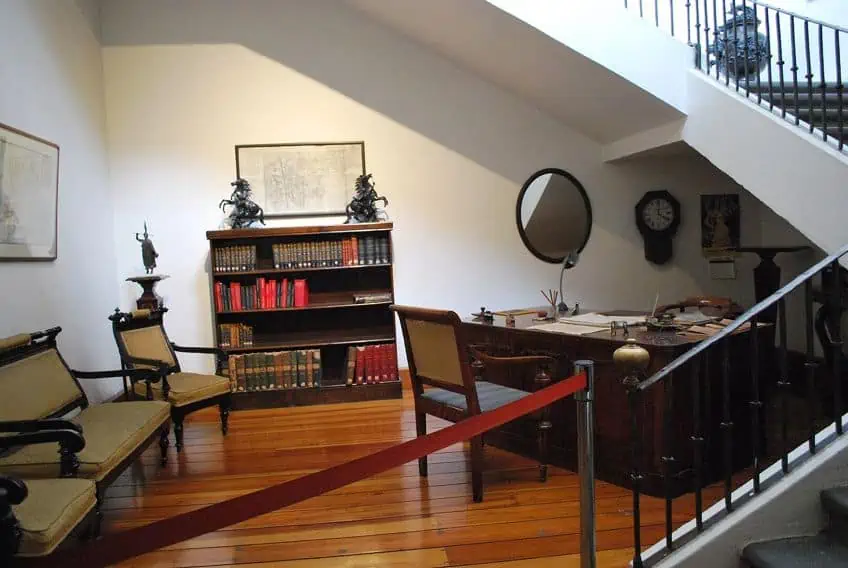
Visual and Conceptual Analysis of Paisaje (Unknown)
| Title | Untitled (Standing Woman Reaching for a Flower) |
| Date | Unknown |
| Medium | Oil on canvas |
| Dimensions (cm) | 20 x 22 |
| Location | National Museum of Art, Mexico City, Mexico |
Paisaje by Joaquín Clausell exemplifies the profound influence of European Impressionism on the artist’s work. The painting depicts a serene countryside with thick, fluid brushwork. In the foreground, a textured field combines various shades of yellow, blue, green, and orange, reminiscent of Pissarro’s (1830-1903) and Sisley’s (1839-1899) art. In contrast, a distant blue tower disrupts the otherwise balanced composition against a backdrop of dark green and blue vegetation.
The sky above mirrors the fluidity of the grassland. Clausell’s tactile brushwork enhances the painting’s appeal.
Conceptually, Paisaje showcases Clausell’s mastery of Impressionism’s visual language, translating it to the Mexican landscape. The artwork idealizes nature, removing signs of modernity except for the tower. The brushwork and color palette, though Impressionist, fuse with Mexican sensibilities, marking Clausell’s unique style within the genre. Historian Jim Lane suggests Clausell introduced Impressionism to Mexico, blending it with Mexican identity.
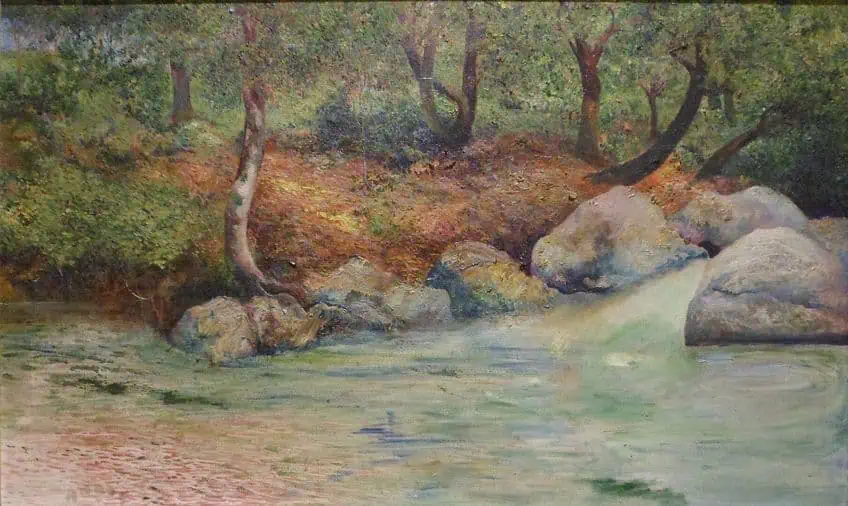
Diego Rivera (1886 – 1957)
| Date of Birth | 8 December 1886 |
| Date of Death | 24 November 1957 |
| Place of Birth | Guanajuato, Mexico |
| Art Movements | Cubism, Modern art, Impressionism, Realism, Post-Impressionism, and Social realism |
| Popular Themes | Social unevenness, the connection between nature, enterprise, and technology, and the chronology and destiny of Mexico |
Diego Rivera, a towering figure in the annals of 20th-century art, emerges as an iconic Mexican muralist and a passionate advocate for social and political change. Born in 1886 in Guanajuato, Mexico, Rivera’s artistic journey spanned continents and epochs, marked by an unwavering commitment to depicting the complexities of the human experience.
His art, characterized by monumental murals and a distinctive blend of realism and symbolism, served as a powerful lens through which he explored the cultural and political landscape of Mexico and the world.
Rivera’s work often featured themes of labor, revolution, and the indigenous heritage of Mexico, weaving a rich tapestry of visual narratives that spoke to the struggles and aspirations of the common people. His collaborations with fellow artists and his prominent role in the Mexican muralist movement further solidified his legacy as a beacon of artistic activism and a visionary champion of social justice. Diego Rivera’s enduring impact on both the art world and the global struggle for equality and human rights stands as a testament to the profound and transformative power of art.

Visual and Conceptual Analysis of Man at the Crossroads (2000)
| Title | Man at the Crossroads |
| Date | 2000 |
| Medium | Fresco |
| Dimensions (cm) | 485 × 1145 |
| Location | 30 Rockefeller Plaza, New York City, United States |
Man at the Crossroads by Diego Rivera is an iconic mural that encapsulates the artist’s masterful blend of visual storytelling and political commentary. Visually, the mural is a tour de force of intricate detail and grandeur, stretching across an expansive wall. At the center of the composition stands a powerful depiction of an allegorical figure, representing humanity at a critical juncture.
Surrounding this central figure are a multitude of scenes, symbols, and historical figures, all interwoven to convey a complex narrative.
Conceptually, Man at the Crossroads is a profound exploration of societal choices and their consequences. Rivera originally created this mural for the Rockefeller Center in New York City, intending to depict the potential for both utopian and dystopian futures. The central figure holds the blueprint of modern industry in one hand and a crystal globe symbolizing the world in the other, highlighting the pivotal role of science and industry in shaping our destiny. Surrounding vignettes depict contrasting scenes of technological progress and social struggle, emphasizing the choices society faces on its path forward.
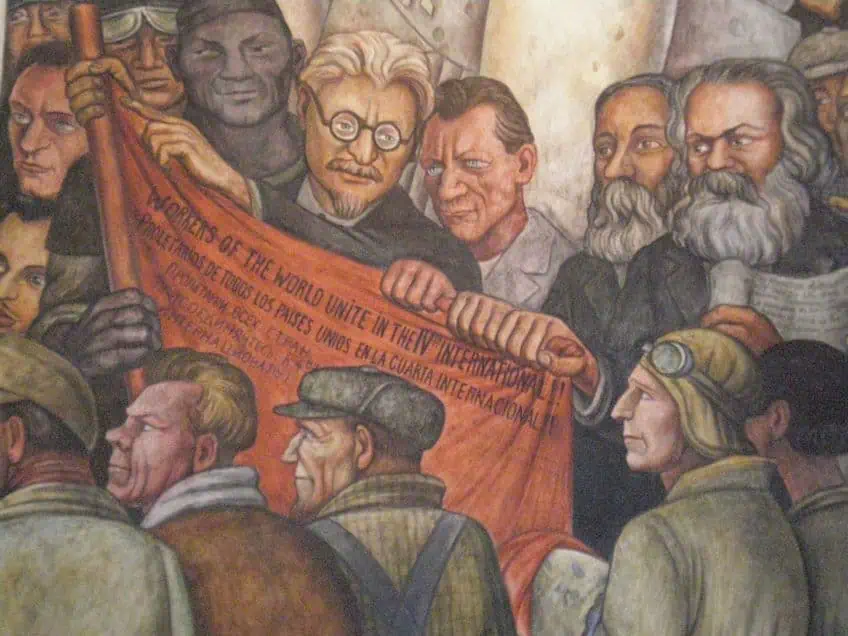
Adolfo Best Maugard (1891 – 1964)
| Date of Birth | 11 June 1891 |
| Date of Death | 25 August 1964 |
| Place of Birth | Mexico City, Mexico |
| Art Movements | Modern art |
| Popular Themes | Mexican folk art and figurative caricatures |
Adolfo Best Maugard was a Mexican artist and cultural luminary who made significant contributions to the realm of art education and the promotion of indigenous Mexican artistic traditions. Born in Mexico City, Best Maugard’s influence on Mexican art was profound, particularly in the early 20th century.
He is best known for his development of the “Mexican School of Painting,” which sought to codify and promote pre-Columbian and indigenous artistic techniques, serving as a foundational framework for the Mexican muralist movement.
Best Maugard’s innovative artistic approach aimed to revitalize and celebrate Mexico’s rich cultural heritage, fostering a renewed sense of pride and identity among Mexican artists. His pioneering work in art education, advocacy for indigenous artistic traditions, and his role as a cultural bridge between Mexico and the world cemented his legacy as a pivotal figure in the shaping of modern Mexican art and cultural identity.

Visual and Conceptual Analysis of Untitled (Standing Woman Reaching for a Flower) (1926)
| Title | Untitled (Standing Woman Reaching for a Flower) |
| Date | 1926 |
| Medium | Oil on canvas |
| Dimensions (cm) | 60 x 50 |
| Location | Unknown |
Visually, Best Maugard’s paintings often reflect the influence of his interest in pre-Columbian and indigenous Mexican art, as does Untitled (Standing Woman Reaching for a Flower). The painting’s simplified forms, bold lines, and a focus on geometric shapes are inspired by pre-Columbian Mexican sculptures. Whereas the stylized and decorative approach reminds us of the aesthetics of ancient Mexican art forms.
His color palettes are earthy and vibrant, drawing inspiration from the natural world and indigenous traditions.
Conceptually, Untitled (Standing Woman Reaching for a Flower) is imbued with a deep appreciation for Mexican cultural heritage – as it reflects a modern take on ancient themes. Traditional Mexican motifs he used in this work are the abundance and closeness to nature and the fertility of the land represented in the female figure.

David Alfaro Siqueiros (1896 – 1974)
| Date of Birth | 29 December 1896 |
| Date of Death | 6 January 1974 |
| Place of Birth | Camargo, Mexico |
| Art Movements | Surrealism, Expressionism, and Symbolism |
| Popular Themes | Mexico’s pre-colonial history and culture, politics, economics, and socialism |
David Alfaro Siqueiros, a towering figure in the realm of 20th-century Mexican art, emerges as a trailblazing muralist and a relentless champion of social justice through his profound artistic endeavors. Born in 1896, Siqueiros’ career unfolded against the backdrop of a turbulent Mexico and a world undergoing dramatic transformation.
His art, marked by bold strokes and vivid colors, reflected his genuine commitment to progressive ideologies and his tireless quest to provoke social change.
Siqueiros harnessed the power of large-scale murals to amplify his message, often tackling themes of labor, revolution, and the enduring resilience of the Mexican people. His work transcends mere aesthetics, embodying a passionate call for political awakening and human solidarity. Through his art, Siqueiros left an indelible mark on the global art scene, standing as an unwavering symbol of artistic activism and unwavering dedication to the betterment of society.

Visual and Conceptual Analysis of Death to the Invader (1942)
| Title | Death to the Invader |
| Date | 1942 |
| Medium | Pyroxylin (mural) |
| Dimensions (cm) | Unknown |
| Location | Polyforum Cultural Siqueiros, Mexico City, Mexico |
Death to the Invader by David Alfaro Siqueiros is a striking and politically charged mural that encapsulates the artist’s passionate dedication to social justice and his profound impact on Mexican muralism. The mural, created in 1942 at the Polyforum Cultural Siqueiros in Mexico City, presents a visually arresting scene that depicts the struggle of the Mexican people against foreign invaders.
Visually, the mural is characterized by dynamic and sweeping compositions, where powerful figures and dramatic contrasts between light and shadow dominate the scene.
Siqueiros employs bold, muscular forms, reminiscent of the Mexican muralist tradition, to depict the heroic resistance of the Mexican people against foreign oppression. The central figure, a defiant and muscular worker, thrust a spear into the invading soldier, symbolizing the collective strength and resilience of the Mexican populace. The intricate interplay of light and shadow adds depth and intensity to the mural, creating a sense of urgency and dynamism.
Conceptually, Death to the Invader is a poignant reflection of Siqueiros’ political convictions and his unwavering dedication to representing the struggles of the marginalized. The mural serves as a powerful allegory for the Mexican Revolution and the ongoing fight against imperialism and foreign domination. Siqueiros’ choice of the worker as the central figure underscores his belief in the transformative potential of the labor movement and the power of the masses to bring about change.
Rufino Tamayo (1899 – 1991)
| Date of Birth | 25 August 1899 |
| Date of Death | 24 June 1991 |
| Place of Birth | Oaxaca, Mexico |
| Art Movements | Modernism, and a mix of Impressionism, Cubism, Fauvism, and ancient Mexican arts |
| Popular Themes | The transitory nature of civilization, and humans’ yearning for the everlasting |
Rufino Tamayo, a prominent Mexican artist, stands as a distinctive figure in the world of modern art. Born in 1899 in Oaxaca, Mexico, Tamayo’s work transcends traditional artistic boundaries, seamlessly blending elements of indigenous Mexican culture with modernist aesthetics.
His art is marked by a rich palette, bold geometric forms, and a profound exploration of the human condition.
Tamayo’s subjects often include striking depictions of human figures, animals, and abstract symbols, reflecting his deep connection to the cultural and artistic traditions of Mexico. His paintings and sculptures reveal a fascination with universal themes such as life, death, and the human spirit, all filtered through a uniquely Mexican lens. Tamayo’s innovative approach to art and his unwavering commitment to preserving the essence of Mexican culture continue to influence and inspire artists worldwide, leaving an enduring mark on the global art landscape.

Visual and Conceptual Analysis of Woman in Gray (1959)
| Title | Woman in Gray |
| Date | 1959 |
| Medium | Oil on canvas |
| Dimensions (cm) | 195 x 129.5 |
| Location | Solomon R. Guggenheim Museum, New York City, United States |
Woman in Grey by Rufino Tamayo is a captivating piece that showcases the artist’s distinctive blend of modernist sensibilities and a deep connection to Mexican culture. Visually, the painting features a woman, elegantly draped in shades of gray, standing against an earthy ochre background with a strip of vivid, almost electric, blue running vertically through it. Tamayo’s use of color and form forms a remarkable contrast that pulls the onlooker’s attention to the central figure.
The woman’s elongated, almost ethereal form, rendered with simplified and abstract lines, imparts a sense of graceful movement and timelessness.
Conceptually, Woman in Grey reflects Tamayo’s exploration of the human form and the essence of Mexican identity. While his style was often abstract and modern, Tamayo’s work maintained a deep reverence for indigenous Mexican culture. In this painting, the woman’s enigmatic expression and posture suggest a sense of introspection and mystery, inviting viewers to contemplate the complexities of the human experience. The use of gray, a color often associated with neutrality and ambiguity, adds an element of ambiguity to the subject’s identity, allowing for multiple interpretations. Overall, Woman in Grey exemplifies Tamayo’s ability to bridge the gap between the contemporary and the traditional, offering a visual and conceptual exploration of Mexican identity and the universal aspects of human existence.

Rosario Cabrera (1901 – 1975)
| Date of Birth | 5 June 1901 |
| Date of Death | 30 December 1975 |
| Place of Birth | Mexico City, Mexico |
| Art Movements | Mexican Renaissance, Realism, and Impressionism |
| Popular Themes | Landscapes and portraits |
Rosario Cabrera was a pioneering painter from Mexico and muralist, whose creative legacy left an indelible mark on the Mexican art scene. Born in Mexico City, Cabrera’s artistic journey unfolded amidst the cultural and political ferment of her time. Her art, characterized by vibrant colors and a blend of indigenous Mexican and European influences, offered a unique perspective on Mexican identity and heritage.
Cabrera’s works often depicted scenes of everyday life, landscapes, and indigenous traditions, evoking a sense of nostalgia and cultural pride.
Her dedication to preserving Mexican traditions extended to her role as an art educator, where she influenced and inspired generations of aspiring artists. Rosario Cabrera’s enduring contributions to Mexican art continue to be celebrated, as her work remains a vivid testament to the beauty and richness of Mexican culture.
Visual and Conceptual Analysis of Red House (1926)
| Title | Red House |
| Date | 1926 |
| Medium | Oil on canvas |
| Dimensions (cm) | 60 x 50 |
| Location | Unknown |
Red House stands as a testament to Rosario Cabrera’s European experiences, drawing inspiration from the architectural wonders she encountered in cities like Amsterdam, Brussels, and Bruges.
The canvas exudes a scholarly proficiency of compositional components and careful awareness of detail, reminiscent of the Flemish artistic practice.
This meticulous approach is complemented by the basic color palette often associated with the Open-Air Painting Schools. The tonal distinctions within the artwork and the meticulous rendering of its elements combine to create a piece that bridges traditional artistic quality with the aesthetics of Naïve art, a fundamental aspect of its creation. Red House encapsulates the fusion of influences that defined Rosario Cabrera’s artistic journey, reflecting her rich and multifaceted artistic sensibility.
María Izquierdo (1902 – 1955)
| Date of Birth | 30 October 1902 |
| Date of Death | 2 December 1955 |
| Place of Birth | San Juan de los Lagos, Mexico |
| Art Movements | Surrealism and folk art |
| Popular Themes | Circuses, horses, still lifes, self-portraits, and portraits |
María Izquierdo was a trailblazing Mexican artist who defied artistic norms and left an indelible mark on the Mexican art scene. Born in San Juan de los Lagos, Mexico, Izquierdo’s career unfolded during a time when the Mexican art world was largely dominated by male artists.
Nevertheless, she fearlessly forged her path, creating a distinctive body of work that combined elements of traditional Mexican folk art and modernist aesthetics.
Her paintings often featured vibrant colors, evocative symbolism, and an exploration of Mexican identity and culture. Izquierdo’s art transcended conventional categorizations, merging surrealism, folk art, and narrative storytelling to depict her unique perspective on the world. Her contributions to Mexican art challenged existing paradigms and paved the way for subsequent generations of women artists, solidifying her legacy as a pioneering figure in Mexican and international art history.

Visual and Conceptual Analysis of Alegoría de la Libertad (Allegory of Freedom) (1937)
| Title | Alegoría de la Libertad (Allegory of Freedom) |
| Date | 1937 |
| Medium | Watercolor on paper |
| Dimensions (cm) | 21 x 26.5 |
| Location | Blaisten Collection Museum, Mexico City, Mexico |
Alegoría de la Libertad (Allegory of Freedom) is a striking painting that seamlessly blends visual and conceptual elements. Visually, the artwork is characterized by a rich and vivid color palette, featuring a female figure at its center. This central figure, depicted with flowing robes, holds a torch high above her head, while her other hand clutches a broken chain. She stands atop a rocky outcrop against a surreal, dreamlike landscape.
The background consists of undulating hills, a turbulent sea, and a radiant sun, all contributing to the composition’s dynamic and almost otherworldly quality.
Conceptually, Alegoría de la Libertad is a powerful meditation on the theme of freedom. The central figure, evoking the classical symbolism of liberty, exudes a sense of strength and empowerment. Her raised torch symbolizes enlightenment and the triumph of knowledge over oppression, while the broken chain signifies liberation from bondage. The surrounding landscape, with its surreal elements, suggests the idea of a limitless, boundless freedom that transcends conventional boundaries. María Izquierdo’s work here reflects her ability to infuse her art with symbolism and a deep exploration of human themes, inviting viewers to engage in a visual and conceptual exploration of the enduring and universal concept of freedom.
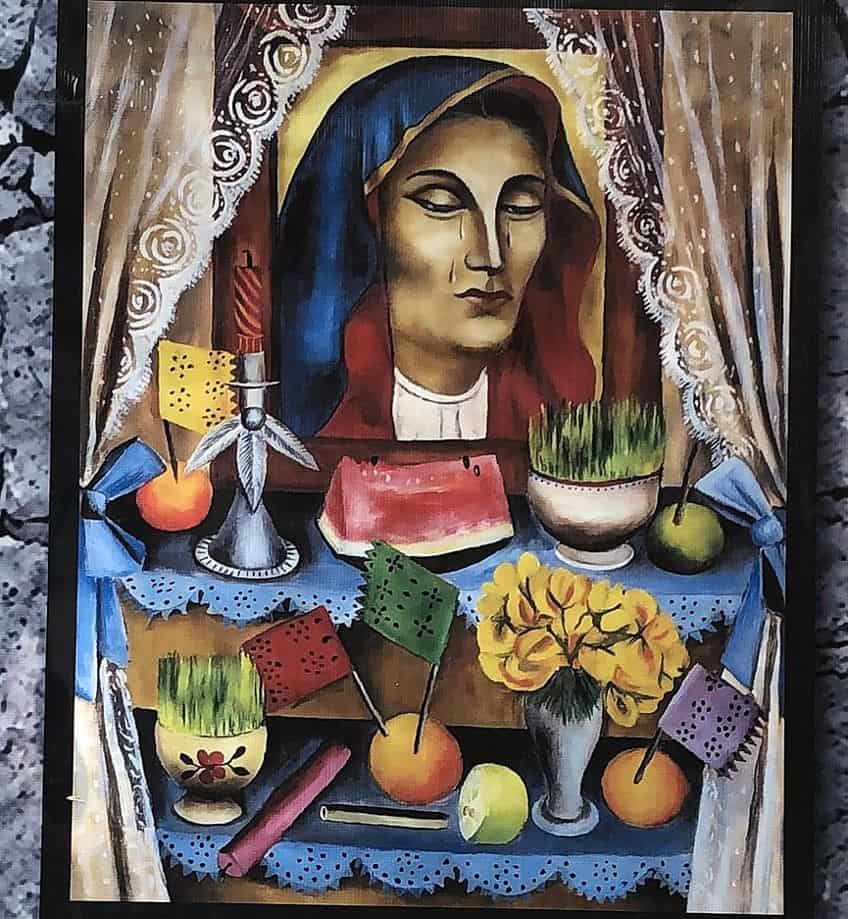
Frida Kahlo (1907 – 1954)
| Date of Birth | 6 July 1907 |
| Date of Death | 4 October 1954 |
| Place of Birth | Mexico City, Mexico |
| Art Movements | Surrealism, Expressionism, and Symbolism |
| Popular Themes | Mortality, physical and emotional pain, love, heritage, identity, and sexuality |
Frida Kahlo, an enigmatic and iconic figure in the world of art, remains a symbol of resilience, individuality, and unapologetic self-expression. Born in 1907 in Coyoacán, Mexico, Kahlo’s life was marked by both physical and emotional challenges, which profoundly influenced her art.
Her distinctive style blends Surrealism with a deeply personal touch, characterized by vivid self-portraits that explore themes of pain, identity, and gender.
Through her paintings, Kahlo bared her soul, using her art as a powerful means of catharsis and a medium for examining her tumultuous life experiences. Her unflinching exploration of her physical suffering and inner turmoil has left an indelible mark on the art world, inspiring countless admirers and cementing her status as a feminist icon and a symbol of artistic authenticity. Frida Kahlo’s legacy endures not only for her captivating visual language but also for her unyielding spirit and courage in the face of adversity.

Visual and Conceptual Analysis of Self-portrait on the Borderline Between Mexico and the United States (1932)
| Title | Self-portrait on the Borderline Between Mexico and the United States |
| Date | 1932 |
| Medium | Oil on copper plate |
| Dimensions (cm) | 31.75 x 34.925 |
| Location | Private collection |
Self-portrait on the Borderline Between Mexico and the United States by Frida Kahlo is a mesmerizing and thought-provoking masterpiece that offers a profound glimpse into the complex identity and emotional terrain of the artist. In this self-portrait, Kahlo stands at the literal and metaphorical crossroads between her Mexican heritage and the influence of the United States, a reflection of the tumultuous and transformative period in her life.
Visually, Kahlo presents herself with striking detail and meticulous precision.
Her iconic unibrow, adorned with a delicate gold necklace, and her signature Tehuana attire emphasize her strong connection to Mexican culture. Yet, she stands against a backdrop that blends elements of both nations, with the left half resembling a traditional Mexican landscape and the right half transitioning into an industrialized, modern cityscape of New York. This visual duality underscores the complex relationship she had with her dual identity.
Conceptually, Kahlo’s self-portrait is a powerful exploration of the inner conflict she experienced as a Mexican artist navigating the cultural influences of the United States. The borderline she references is not just a geographical one but also a psychological and emotional divide. Her hauntingly penetrating gaze, with a tear trickling down her cheek, hints at the pain and disconnection she felt during her time in the United States.
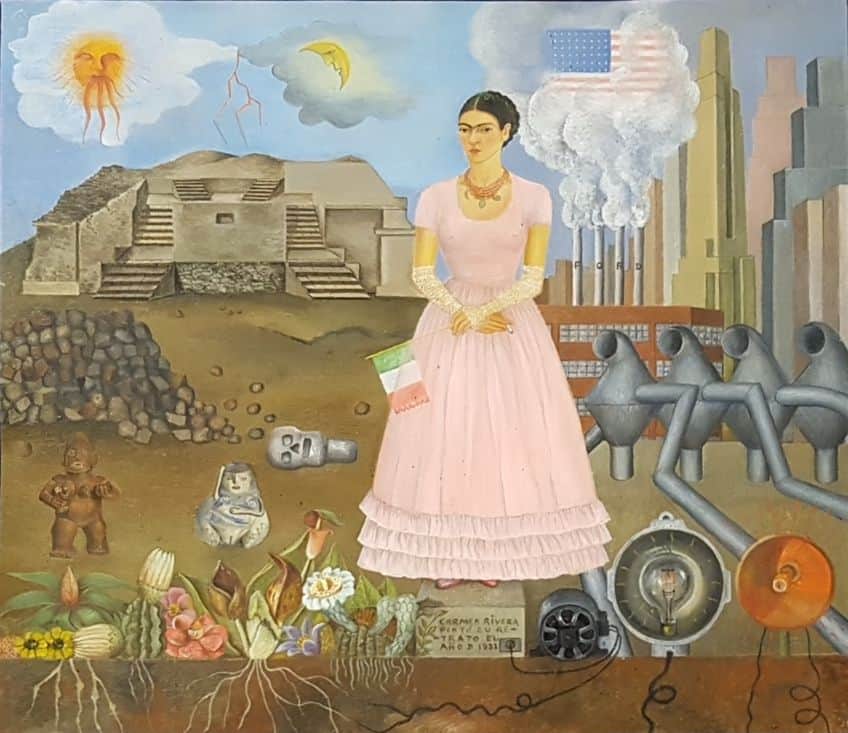
Francisco Eppens Helguera (1913 – 1990)
| Date of Birth | 1 February 1913 |
| Date of Death | 6 September 1990 |
| Place of Birth | San Luis Potosi, Mexico |
| Art Movements | Mexican Renaissance |
| Popular Themes | Aztec and colonial architecture, folklife, the Mexican symbols, animals, and Catholic traditions |
Francisco Eppens Helguera, a distinguished Mexican sculptor and painter, emerges as a visionary figure in the world of modern art. Born in 1913 in Mexico City, Eppens Helguera’s work deftly bridges the realms of sculpture, public art, and architectural integration.
His sculptures, characterized by their dynamic forms and harmonious lines, often evoke a sense of fluidity and grace.
Eppens Helguera’s artistic repertoire is celebrated for its integration into urban spaces, enriching the public environment with his compelling creations. Throughout his career, he maintained a deep connection to Mexican culture and history, and this influence is evident in his choice of subjects, often drawing from indigenous Mexican traditions and mythology.

Visual and Conceptual Analysis of La Vida, La Muerte, El Mestizaje y Los Cuatro Elementos (Life, Death, Mestizaje, and the Four Elements) (1954)
| Title | Life, Death, Mestizaje, and the Four Elements |
| Date | 1954 |
| Medium | Mural |
| Dimensions (cm) | Unknown |
| Location | UNAM, Mexico City, Mexico |
The mural Life, Death, Mestizaje, and the Four Elements painted by Francisco Eppens Helguera is a striking and thought-provoking work of art that seamlessly blends visual and conceptual elements. Visually, the mural is a grand and intricate composition featuring graceful, intertwined figures that seem to flow and meld into one another.
These figures are harmoniously intertwined with symbolic representations of the four elements: earth, water, air, and fire, creating a dynamic and balanced visual narrative.
Conceptually, the mural delves into profound themes, particularly the interplay between life and death, as well as the concept of mestizaje, which signifies the blending of different cultures and identities. The intertwining figures symbolize the interconnectedness of human existence, emphasizing the cyclical nature of life and death. The incorporation of the four elements underscores the deep-rooted connection between humanity and the natural world, highlighting our dependence on these elemental forces.
Julio Galán (1958 – 2006)
| Date of Birth | 5 December 1958 |
| Date of Death | 4 August 2006 |
| Place of Birth | Múzquiz Municipality, Melchor Múzquiz, Mexico |
| Art Movements | Modern art |
| Popular Themes | Pre-Columbian cultures, homosexuality, and Roman Catholicism |
Julio Galán (1958 – 2006) was a profoundly influential Mexican contemporary artist known for his unique and evocative works that defied conventional artistic categorization. Born in Múzquiz, Mexico, Galán’s brief yet impactful career left a memorable impact on the art world.
His art effortlessly traversed various mediums, including painting, drawing, and sculpture, while his eclectic style was characterized by a rich blend of surrealism, expressionism, and pop art.
Galán’s creations often featured enigmatic and emotionally charged figures, often portrayed in dreamlike and otherworldly settings, inviting viewers to explore the depths of their own consciousness. His deeply personal and introspective art delved into themes of identity, sexuality, and the human condition, and his fearless approach to self-expression challenged societal norms. Julio Galán’s untimely passing in 2006 left a void in contemporary Mexican art, but his legacy endures through the enduring impact of his profound and boundary-pushing work.
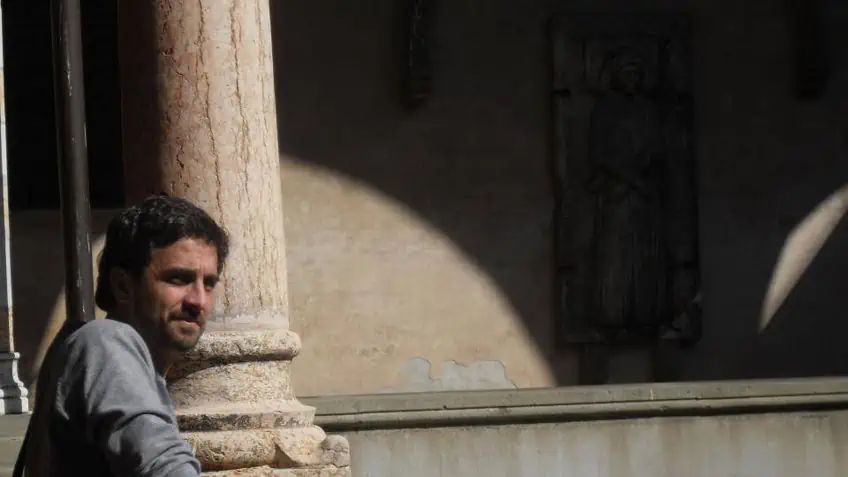
Visual and Conceptual Analysis of Retrato de Elizabeth (2000)
| Title | Retrato de Elizabeth |
| Date | 2000 |
| Medium | Oil on canvas |
| Dimensions (cm) | 190 x 260 |
| Location | Private collection |
Retrato de Elizabeth by Julio Galán is an intriguing artwork that encapsulates the artist’s unique approach to portraiture. Visually, the painting features a young woman, likely the titular Elizabeth, rendered in a distinctive and slightly surreal style. Galán’s use of vivid colors and bold, expressive brushstrokes creates an almost otherworldly quality to the subject, blurring the line between realism and abstraction. The woman’s holding a fan in her hands and sitting relaxed on a chair in a room full of odd elements.
Conceptually, Retrato de Elizabeth speaks to Galán’s fascination with the enigmatic and the subconscious. The dreamlike backdrop with a man’s hand sticking out behind it suggests an exploration of hidden realities and inner complexities. Galán often delved into themes of identity and self-exploration in his work, and this portrait appears to be no exception. The use of vibrant colors and the distortion of the subject’s features may signify an emotional intensity or a departure from conventional portraiture, inviting viewers to ponder the deeper layers of the depicted individual’s psyche.
In conclusion, the world of art has been enriched by the profound contributions of Mexican artists throughout history. From the iconic muralists who reshaped the way we view public spaces to the avant-garde creators who challenged the boundaries of artistic expression, painters from Mexico have left an enduring mark on the global art landscape. Their works are a testament to the diverse cultural tapestry of Mexico, drawing from indigenous traditions, the complexities of Mexican identity, and a deep connection to the land. Whether it’s the vivid landscapes of María Izquierdo, the socially charged murals of Diego Rivera, or the abstract explorations of Rufino Tamayo, the legacy of these famous Mexican painters continues to inspire and captivate art enthusiasts around the world, showcasing the boundless creativity and cultural richness of this vibrant nation.
Take a look at our Mexican painters webstory here!
Frequently Asked Questions
Who Is the Most Famous Mexican Painter?
Determining the single most famous Mexican painter is subjective, as Mexico boasts a rich and diverse artistic heritage with many renowned painters. However, Diego Rivera often holds a prominent place in discussions of the most famous Mexican painter. Rivera’s iconic murals, social commentary, and influence on the Mexican muralist movement have left an indelible mark on the art world. His work is celebrated for its monumental scale, vivid depictions of Mexican history and culture, and powerful political themes. While Rivera’s fame is undeniable, it’s essential to acknowledge that Mexico has been home to numerous exceptional painters, each contributing their unique perspectives and making significant impacts in the world of art.
Who Are the Three Main Mexican Muralists?
The three main Mexican Muralists, often referred to as Los Tres Grandes, are Diego Rivera, David Alfaro Siqueiros, and José Clemente Orozco. These iconic artists played pivotal roles in shaping the Mexican muralist movement during the early to mid-20th century. Their monumental murals, characterized by bold social and political themes, deep connections to Mexican history and culture, and a commitment to making art accessible to the public, had a profound impact on the course of Mexican art and society. Each of these muralists brought their unique vision and style to the movement, leaving an enduring legacy in the world of art and social activism.
What Was the Most Famous Female Painter in 20th-Century Mexico?
Frida Kahlo is undoubtedly the most famous female painter of 20th-century Mexico, and is a globally recognized icon. Her unique and highly personal style, characterized by self-portraits that delved into themes of pain, identity, and Mexican culture, has left an indelible mark on the art world. Kahlo’s works are celebrated for their emotional depth and the way they navigate the complexities of her life, often reflecting her physical and emotional struggles. Her art continues to resonate with audiences worldwide, making her a trailblazing figure in both Mexican and international art history, and a symbol of artistic and feminist empowerment.
Nicolene Burger, a South African multimedia artist and creative consultant, specializes in oil painting and performance art. She earned her BA in Visual Arts from Stellenbosch University in 2017. Nicolene’s artistic journey includes exhibitions in South Korea, participation in the 2019 ICA Live Art Workshop, and solo exhibitions. She is currently pursuing a practice-based master’s degree in theater and performance. Nicolene focuses on fostering sustainable creative practices and offers coaching sessions for fellow artists, emphasizing the profound communicative power of art for healing and connection. Nicolene writes blog posts on art history for artfilemagazine with a focus on famous artists and contemporary art.
Learn more about Nicolene Burger and about us.
Cite this Article
Nicolene, Burger, “Famous Mexican Painters – A List of the 10 Best Artists.” artfilemagazine – Your Online Art Source. September 26, 2023. URL: https://artfilemagazine.com/famous-mexican-painters/
Burger, N. (2023, 26 September). Famous Mexican Painters – A List of the 10 Best Artists. artfilemagazine – Your Online Art Source. https://artfilemagazine.com/famous-mexican-painters/
Burger, Nicolene. “Famous Mexican Painters – A List of the 10 Best Artists.” artfilemagazine – Your Online Art Source, September 26, 2023. https://artfilemagazine.com/famous-mexican-painters/.


